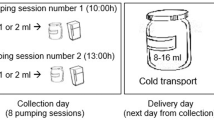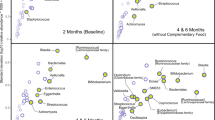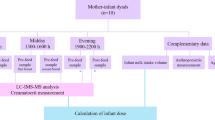Abstract
Background/objectives:
The fatty acid (FA) composition of breast milk throughout the period of lactation is fairly well understood. What is not known, however, is the FA composition of breast milk at the interface of physiology and pathology of pregnancy. We therefore decided to analyse and compare the differences in the FA composition of transitional and mature milk of mothers who delivered small for gestational age (SGA) neonates born at term; infants delivered at 35–37 weeks of gestation, that is ‘late preterm’; and that of mothers who gave birth to appropriate for gestational age neonates (AGA).
Subject/methods:
The FAs were analysed by HPLC equipped with MS detector.
Results:
We found differences in the percentage share of the studied FA pool regarding levels of capric, lauric and gadoleic acids. Comparing transitional and mature milk, the greatest diversity was seen in the group of mothers of AGA neonates and the least was noted in the group of mothers of SGA neonates.
Conclusions:
Both ‘late prematurity’ and reduced neonatal weight of children born at term affect the FA composition of breast milk. Even a small degree of fetal malformation alters the composition of breast milk, which is probably related to the child’s needs and condition.
This is a preview of subscription content, access via your institution
Access options
Subscribe to this journal
Receive 12 print issues and online access
$259.00 per year
only $21.58 per issue
Buy this article
- Purchase on Springer Link
- Instant access to full article PDF
Prices may be subject to local taxes which are calculated during checkout



Similar content being viewed by others
References
Blaymore-Bier J-A, Oliver T, Ferguson AE, Vohr BR . Human milk improves cognitive and motor development of premature infants during infancy. J Hum Lact 2002; 18: 361–367.
Rebuffé-Scrive M, Enk L, Croma N . Fat cell metabolism in different regions in women. Effect of menstrual cycle, pregnancy and lactation. J Clin Invest 1985; 75: 1973–1976.
Rodriguez-Palmero M, Koletzko B, Kunz C, Jensen R . Nutritional and biochemical properties of human milk: II Lipids, micronutrients, and bioactive factors. Clin Perinatol 1999; 26: 335–359.
Koletzko B, Rodriguez-Palmero M, Demmelmair H, Fidler N, Jensen R, Sauerwald T . Physiological aspects of human milk lipids. Early Hum Dev 2001; 65: S3–S18.
Haggarty P . Effect of placental function on fatty acid requirements during pregnancy. Eur J Clin Nutr 2004; 58: 1559–1570.
Herrera E . Implications of dietary fatty acids during pregnancy on placental, fetal and postnatal development—a review. Placenta 2002; 16: 9–19.
Smithers LG, Markrides M, Gibson RA . Human milk fatty acids from lactating mothers of preterm infants: a study revealing wide intra- and inter-individual variation. Prostaglandins Leukot Essent Fatty Acids 2010; 83: 9–13.
Ribeiro M, Balcao V, Guimaraes H, Rocha G, Moutinho C, Matos C et al. Fatty acid profile of human milk of Portuguese lactating women: prospective study from the 1st to the 16th week of lactation. Ann Nutr Metab 2008; 53: 50–56.
Bokor S, Koletzko B, Decsi T . Systematic review of fatty acid composition of human milk from mothers of preterm compared to full-term infants. Ann Nutr Metab 2007; 51: 550–556.
López-López A, López-Sabater MC, Campoy-Folgoso C, Rivero-Urgell M, Castellote-Bargallo AI . Fatty acid and sn-2 fatty acid composition in human milk from Granada (Spain) and in infant formulas. Eur J Clin Nutr 2002; 56: 242–1254.
Genzel-Boroviczény O, Wahle J, Koletzko B . Fatty acid composition of human milk during the 1st month after term and preterm delivery. Eur J Pediatr 1997; 156: 142–147.
Bahrami G, Rahimi Z . Fatty acid composition of human milk in Western Iran. Eur J Clin Nutr 2005; 59: 494–497.
Moltó-Puigmartí C, Castellote AI, Carbonell-Estrany X, López-Sabater MC . Differences in fat content and fatty acid proportions among colostrum, transitional, and mature milk from women delivering very preterm, preterm and term infants. Clin Nutr 2011; 30: 116–123.
Wang L, Shimizu Y, Kaneko S, Hanaka S, Abe T, Shimasaki H et al. Comparison of the fatty acid composition of total lipids and phospholipids in breast milk from Japanese women. Pediatr Int 2000; 42: 14–20.
Xiang M, Lei S, Li T, Zetterström R . Composition of long chain polyunsaturated fatty acids in human milk and growth of young infants in rural areas of northern China. Acta Paediatr 1999; 88: 126–131.
Bobiński R, Mikulska M, Mojska H, Simon M . Comparison of the fatty acid composition of maternal blood and cord blood of mothers who delivered healthy full-term babies, preterm babies, and full-term small for gestational age infants. J Mat Fet Neonatal Med 2013; 26: 96–102.
Folch J, Lees M, Stanley GHS . A simple method for the isolation and purification of total lipids from animal tissues. J Biol Chem 1957; 226: 497–509.
Bitman J, Wood L, Hamosh M, Hamosh P, Metha NR . Comparison of the lipid composition of breast milk from mothers of term and preterm infants. Am J Clin Nutr 1983; 38: 300–312.
Milligan LA, Bazinet RP . Evolutionary modifications of human milk composition: evidence from long chain polyunsaturated fatty acid composition of anthropoid milks. J Hum Evol 2008; 55: 1086–1095.
Smit EN, Martini IA, Kemperman RFJ, Schaafsma A, Muskiet FA, Boersma ER . Fatty acids in formulae for term infants: compliance of present recommendations with the actual human milk fatty acid composition of geographically different populations. Acta Paediatr 2003; 92: 790–796.
Schmeits BL, Okolo SN, Vanderjagt DJ, Huang Y-S, Chuang L-T, Mata JR et al. Content of lipid nutrients in milk of Fulani women. J Hum Lact 1999; 15: 113–120.
Jensen R . The lipids in human milk. Prog Lipid Res 1996; 35: 63–73.
McGarry J, Foster D . Regulation of hepatic fatty acid oxidation and ketone body production. Annu Rev Biochem 1980; 49: 395–420.
Hamosh M . Enzymes in human milk. In: Jensen RG eds. Handbook of Milk Composition. Academic Press: San Diego, CA, 388–427, 1995.
Blanchette-Mackie E . Lipoprotein lipase and fatty acid transport in heart adipose tissue and mammary gland: immuno and cytochemistry. Endocr Regul 1991; 25: 63–69.
Garg M, Bassilian MS, Bell C, Lee S, Lee WNP . Hepatic de novo lipogenesis in stable low-birth-weight infants during exclusive breast milk feedings and during parenteral nutrition. J Parent Enter Nutr 2005; 29: 81–86.
Merino DM, Ma DWL, Mutch DM . Genetic variation in lipid desaturases and its impact on the development of human disease. Lipids Health Dis 2010; 9: 63–71.
Nakbi A, Tayeb W, Dabbou S, Issaoui M, Grissa AK, Attia N et al. Dietary olive oil effect on antioxidant status and fatty acid profile in the erythrocyte of 2,4-D-exposed rats. Lipids Health Dis 2010; 9: 89–98.
Nakbi A, Tayeb W, Grissa A, Issaoui M, Dabbou S, Chargui I et al. Effects of olive oil and its fractions on oxidative stress and the liver’s fatty acid composition in 2,4-Dichlorophenoxyacetic acid-treated rats. Nutr Metabol 2010; 7: 80–88.
Acknowledgements
The authors gratefully acknowledge the Nutricia Foundation. The study was supported by grant number RG3/2006.
Author information
Authors and Affiliations
Corresponding author
Ethics declarations
Competing interests
The authors declare no conflict of interest.
Rights and permissions
About this article
Cite this article
Bobiński, R., Mikulska, M., Mojska, H. et al. Comparison of the fatty acid composition of transitional and mature milk of mothers who delivered healthy full-term babies, preterm babies and full-term small for gestational age infants. Eur J Clin Nutr 67, 966–971 (2013). https://doi.org/10.1038/ejcn.2013.96
Received:
Revised:
Accepted:
Published:
Issue Date:
DOI: https://doi.org/10.1038/ejcn.2013.96



